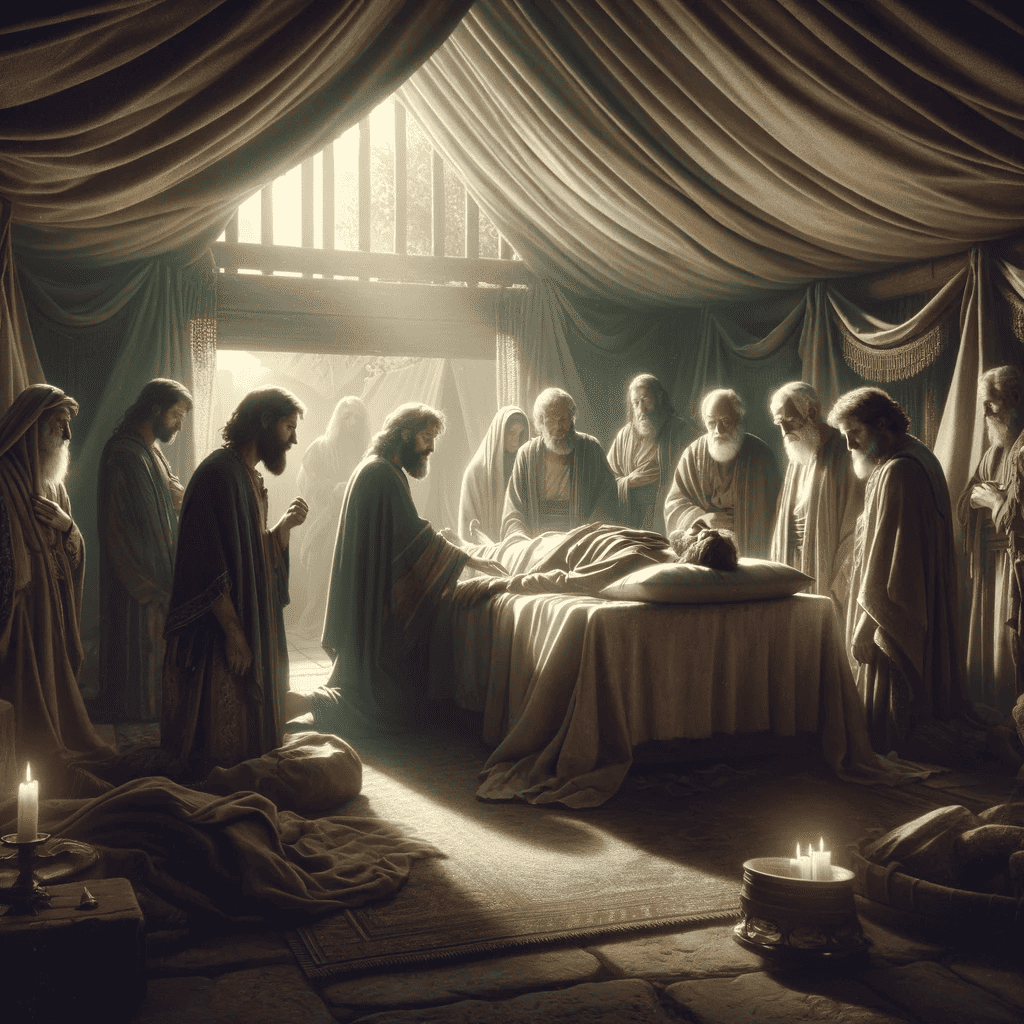
The Death of Isaac, as narrated in Genesis 35:27-29, offers a moment of profound transition and reflection within the biblical narrative, particularly within the context of the patriarchal history. This passage marks the end of Isaac’s journey on earth and serves as a bridge to the continued unfolding of God’s covenant through his descendants.
Isaac, the son of Abraham and Sarah, and the father of Esau and Jacob, returns to Mamre, also known as Hebron, where his father once lived. This place is significant in the Abrahamic family’s history, having been the stage for many of God’s revelations and promises. Isaac’s return to Mamre towards the end of his life symbolizes a full circle, connecting the past promises of God with the present and future fulfillment through his lineage.
At the ripe age of 180, Isaac breathes his last, surrounded by his sons, Esau and Jacob. Despite the earlier discord and rivalry between the two brothers, their coming together at their father’s deathbed signifies a moment of reconciliation and unity. This reunion is not just a personal family moment; it reflects the broader theme of God’s promise to Abraham that his descendants would be as numerous as the stars and that through them, all nations on earth would be blessed.
Isaac’s death and the subsequent burial in the cave of Machpelah, alongside his wife Rebekah and his parents, Abraham and Sarah, underscore the continuity of God’s promises across generations. The cave of Machpelah, purchased by Abraham as a family burial plot, becomes a tangible symbol of the patriarchs’ faith and the enduring covenant between God and Abraham’s descendants.
This moment in Genesis also highlights the legacy of faith passed down through the generations. Isaac, who lived a life marked by faith, patience, and quiet strength, leaves behind a legacy that would shape the destiny of the Israelites. Through his sons, Esau and Jacob, the narrative of God’s chosen people continues to unfold, with Jacob’s lineage leading to the twelve tribes of Israel.
In this reflective transition, the death of Isaac not only marks the end of an era but also sets the stage for the emergence of Jacob (later named Israel) as a central figure in the unfolding narrative of God’s people. As Isaac’s life concludes, the biblical account subtly shifts focus toward the fulfillment of the covenant through Jacob’s lineage, emphasizing the dynamic continuity of God’s promises through generations.
This moment of Isaac’s passing is deeply emblematic of the biblical theme of generational faithfulness to God. Isaac, who had been a living link between Abraham, the father of faith, and Jacob, the bearer of the twelve tribes, now passes the torch of God’s covenantal promise to his descendants. The peaceful passing of Isaac, surrounded by both his sons, despite their earlier strife, signifies a moment of divine grace and reconciliation. It reminds the faithful of the power of forgiveness and the possibility of unity in the midst of previous discord.
Furthermore, Isaac’s death and burial in the cave of Machpelah alongside his ancestors underscore a profound respect for familial bonds and the sacredness of legacy. This burial place, a tangible sign of the family’s history and God’s enduring promise, becomes a place of memory and hope. It is here that the patriarchs rest, each having played their role in the story of God’s people, and each resting in the promise of a future fulfillment that would extend beyond their lifetimes.
The narrative surrounding Isaac’s death also serves as a theological anchor, reminding readers of the covenant’s resilience through trials, separations, and reconciliations. The gathering of Esau and Jacob around their father in his final moments is a poignant testament to the underlying unity that God’s covenant promises to Abraham’s descendants, despite human frailty and conflict. This unity foreshadows the eventual gathering of the tribes of Israel, illustrating how God’s purposes are worked out through both harmony and discord within the chosen family.
As the story progresses beyond Isaac’s death, the biblical text delves deeper into the complexities of Jacob’s life and his twelve sons, who will become the progenitors of the Israelite tribes. The narrative arc from Abraham to Isaac, and then to Jacob, illustrates a divine tapestry woven through human history, where faith, promise, and fulfillment intersect across generations.
In essence, the account of Isaac’s death encapsulates a moment of solemn reflection on the enduring nature of God’s promises and the intricate interplay of faith, legacy, and divine purpose. It reinforces the theme that God’s covenant with Abraham stretches beyond individual lifetimes, moving through history with a momentum that carries forward the hope and promise of redemption for all humanity. This story, rich in symbolism and meaning, invites readers to ponder the depth of God’s faithfulness and the profound legacy of faith that links generations in a continuous story of grace and promise.